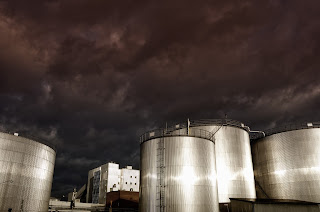 |
| Overhead view of the Arkema plant in Corsby, Texas. Image from United States Chemcial Safety Board |
The recent events at the Arkema chemical plant in Crosby, Texas bring to light the limitations we, as process operators of any type, may put on our own thinking and actions. Though investment was made, and was ongoing, to improve aspects of the plant, the operation was still brought to a standstill and a fire ensued that brought the involvement of the US Chemical Safety Board. This resulted because natural events that were likely deemed impossible became reality, with insufficient contingency operations in place to handle the situation.
What is important about the event is what we can all learn from it, what we can use to modify and improve our own methods of evaluating risk and implementing protections to prevent loss and damage. Essentially, the plant was overwhelmed by storm induced flooding that was unprecedented. Grid and backup power sources were rendered inoperable and material that required refrigeration to maintain a safe condition no longer was provided with the needed cold storage environment.
 |
| Timeline of events related to a fire at the Arkema chemical plant in Crosby, TX Image is from US Chemical Safety Board |
Share and discuss your concerns and plans with process instrumentation and control specialists, leveraging your own knowledge and experience with their resources to develop a better solution.


